In sexually reproducing population only 50% individuals produce offspring, while the rest half just contribute their genes, thus reducing the reproductive capacity, whereas in asexuals all individuals produce offsprings with no apparent help from others. Asexual reproduction saves energy and time.
First there was asexual reproduction in the beginning which was fast and simple but had its disadvantages as it produced clones and could not get rid of harmful effects of mutation.
Early protozoan probably reproduced by asexual means such as binary fission, multiple fission, budding etc. as these methods were quick, had lesser energy demands and all individuals participated in producing offspring.
Asexual reproduction was best suited to animals which had delicate bodies and no apparent defense system and, therefore, must have needed a speedy way of multiplication for the recovery of population. Gametogenesis in protozoan is variable and can be classified in the following three forms:
Reproduction is an important life process to produce young ones of the same kind. As single celled organisms protozoans lack special reproductive structures like gonads. Protozoans reproduce both by asexual and sexual reproduction. Out of these two, asexual reproduction is common. In some of the protozoans asexual reproduction is the only mode of reproduction.
Sexual reproduction takes place by fusion of pronuclei with the formation of gametes or without the formation of the gametes. There are numerous chances of genetic recombination in sexual reproduction. This genetic recombination occurs during the formation of pronuclei and during the fusion. Unlike asexual reproduction, sexual reproduction is induced by the unfavorable conditions. Sexual reproduction in protozoans occur by the following methods,
It is the fusion of the pronuclei of two gametes. This is a complete fusion of the two sex cells resulting in the formation of the zygote. The fusion nucleus of the zygote is called as synkaryon. Depending on the degree of differentiation displayed by the fusing gametes syngamy is of following types:
Autogamy: This is the fusion of the gametes derived from the same parent cell. For example, in Actinophrys during sexual reproduction, the pseudopodia are withdrawn and a cyst is formed. Now a meiotic division takes place and two daughter nuclei with half the number of chromosomes are formed. No cell division takes place but after sometime, gametic nuclei fuse to forma zygote nucleus.
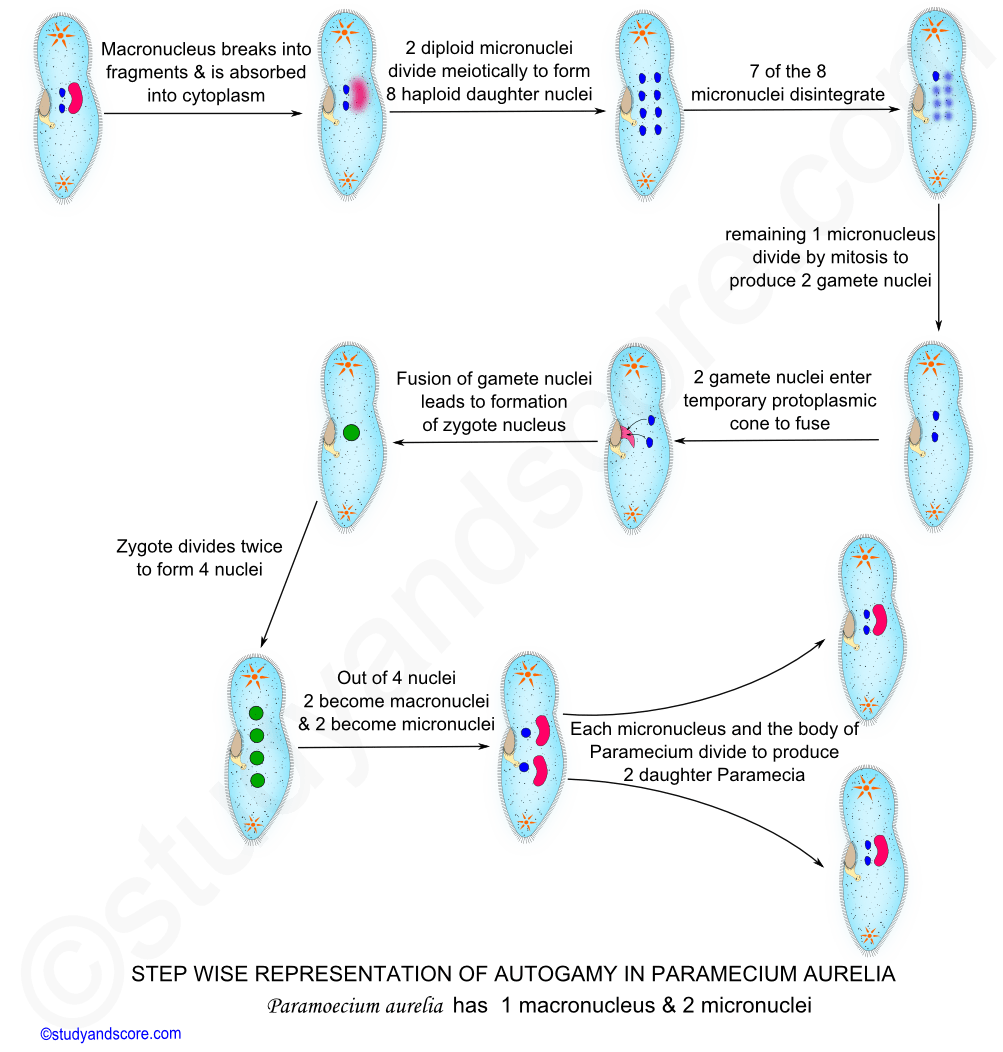
Hologamy: In this type of reproduction, the two mature protozoan individuals themselves behave as gametes and fuse together to form zygote. Hologamy occurs in few species of Sarcodina and Mastigophora. (Ex: Copromonas)
Isogamy: When the two fusing gametes are similar in size and shape but different in behaviour they are called as isogametes. The fusion of the isogametes is called as isogamy. Isogametes are generally produced by multiple fissions. Isogamy is common in few species of Foraminifera (Ex: Elphidium), Gergarinia (Ex: Monocystis) and Phytomonatida (Ex: Chlamydomonas).
Anisogamy: When the two fusing gametes differ morphologically as well as in terms of behaviour they are called as anisogametes. Generally small and motile gametes are male or microgametes whereas the large and non-motile gametes are female or macrogametes. The fusion of two such anisogametes is called as anisogamy. This mode of reproduction is seen in Sporozoa (Ex: Plasmodium), Phytomonatida (Ex: Volvox)
It involves temporary fusion of two individuals called as conjugants at the oral or buccal regions. This type of reproduction is the characteristic of the suctorians and holotrich ciliates.
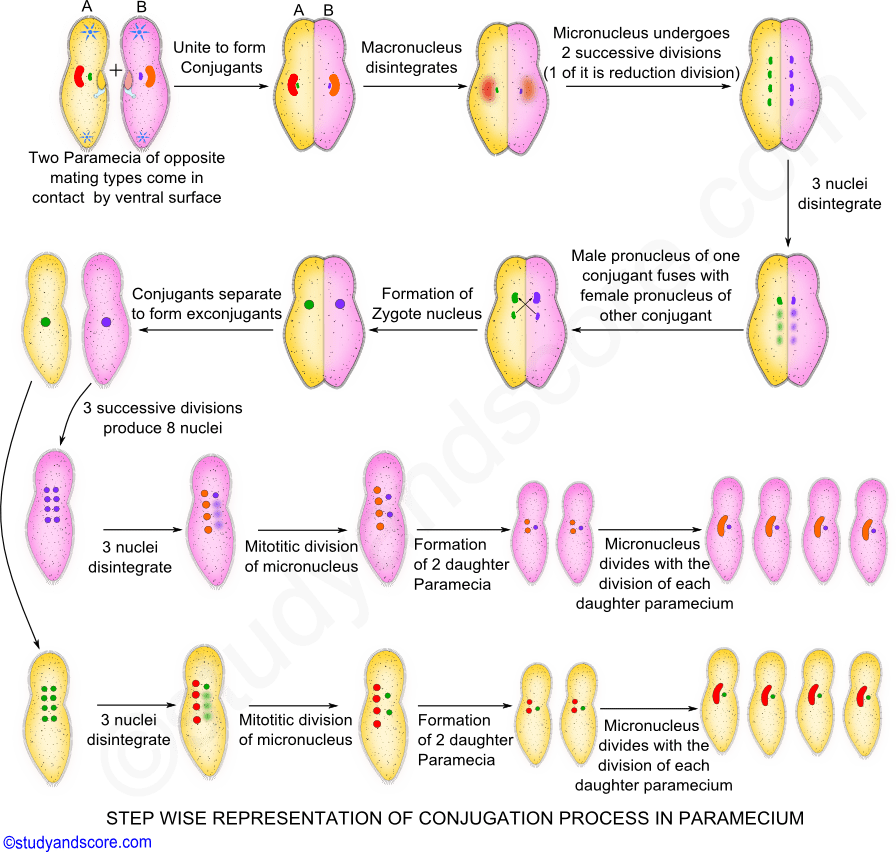
Fusion of the protoplasm takes place at the point of contact. Macronuclei break up and disappear but the micronuclei undergo meiotic division. After the meiotic division of the micronuclei, all the micronuclei get degenerated and only one remains. This remaining micronucleus divides forming two gametic micronuclei. Out of these two one is considered male pronucleus and the other female pronucleus.
The male pronucleus of one of the conjugants moves through fused protoplasm into the other conjugant. In each conjugant, these male and female pronuclei fuse together forming zygote nucleus. Now two individuals separate and are called as ex-conjugants. Each ex-conjugant undergoes further nuclear and cytoplasmic divisions forming four daughter individuals.
The association during the conjugation process is highly specialized. The unique feature of conjugation is the exchange of hereditary material so that each of the conjugant benefits from a renewed hereditary constitution.
Asexual reproduction is the method in which reproduction occurs without the fusion of pronuclei. Asexual reproduction does not generate new genetic recombination. The offspring show uniparental inheritance, without any genetic variations. In protozoans, asexual reproduction occurs only under favorable conditions.
The following are different modes of asexual reproduction occurring in protozoans:
It is the most common method of asexual reproduction where in the parent divides into two daughter individuals. It involves division of nucleus followed by the division of the cytoplasm. The plane of fission differs in different protozoans. Depending on the plane of fission binary fission is of following types:
Irregular binary fission- Binary fission is irregular in some of the protozoans which do not have defined body shape. In these protozoans, there will be no defined plane of fission either and hence the name irregular binary fission. Example: Amoeba
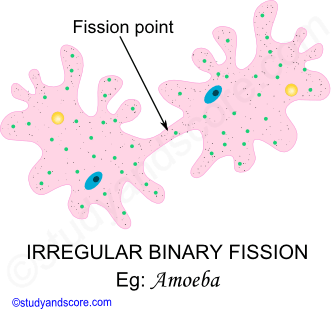
Longitudinal binary fission- Longitudinal binary fission is common in Mastigophoran protozoans and in few ciliophorans also. This type of fission process starts at the anterior end and proceeds towards the posterior end. The plane of fission is parallel to the longitudinal axis of the body of the organism. Example: Euglena, Vorticella
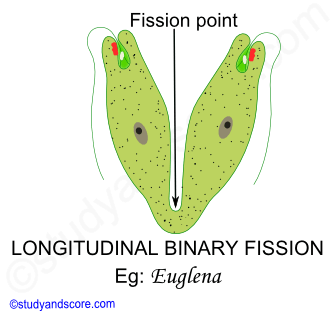
Transverse binary fission- Transverse binary fission is seen in ciliate protozoans. The plane of fission in this type is at right angles to the kineties. All the paramecia produced asexually by repeated binary fission from a single parent constitute a clone. Example: Paramecium
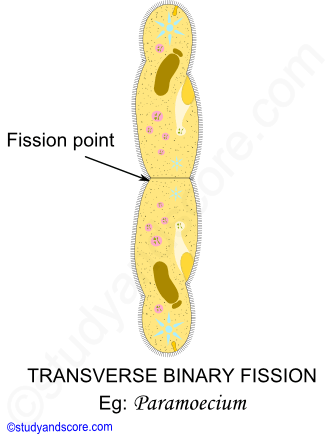
Oblique Binary fission- Oblique binary fission is common in some protozoans like dinoflagellates. In this type the plane of fission is oblique to the body axis of the organism. Example: Ceratium

It is the division of the parent into numerous daughter individuals. Nucleus divides into many nuclei followed by the cytoplasmic division forming many daughter individuals. It is prominent in Sporozoans and Sarcodines.
Schizogony is the asexual kind of multiple fission and its end products of schizogony grow into trophozoites. Gamogony is the sexual kind of multiple fission by which gametes are formed. Also sporogony is also sexual kind of multiple fission by which spores are formed. Example: Aggregata
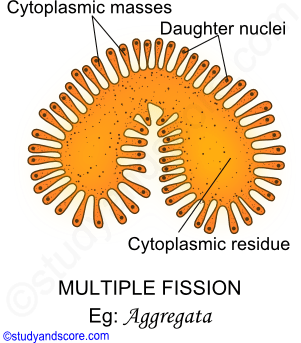
It is common in suctorian protozoans. The bud is a smaller individual formed after nuclear division. Monotonic budding (Vorticella) is seen in ciliates whereas multiple budding is seen in suctorians. Buds can occur either exogenously (Ephelota) or endogenously (Acineta) in some of the protozoans. Example: Acineta, Ephelota, Vorticella

It is the division of a multinucleate protozoan into multinucleate daughter individuals by cytoplasmic division but without nuclear divisions. The parental nuclei are distributed among the daughter individuals. Example: Opalina, Pleomyxa
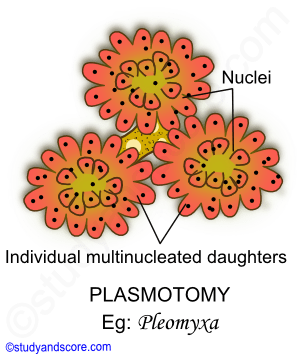

- Share with your friends! -
Login to post your comment here...
- or with social Account -